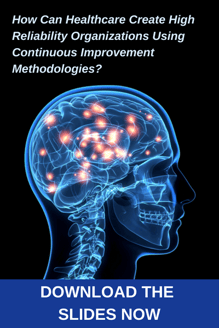BTOES From Home - SPEAKER ...
Courtesy of Nintex Pty's Paul Hsu, below is a transcript of his speaking session on 'Improve employee productivity during and post-COVID by ...
View our schedule of industry leading free to attend virtual conferences.
Each a premier gathering of industry thought leaders and experts sharing key solutions to current challenges.
Watch On-Demand Recording - Access all sessions from progressive thought leaders free of charge
from our industry leading virtual conferences.
The premier Business Transformation & Operational Excellence Conference. Watch sessions on-demand for free.
Use code: BFH1120
Delivered by the industry's most progressive thought leaders from the world's top brands.
Start learning today!
Take a look at our best definitions, learning resources & articles on High Reliability Organizations.

High Reliability Organizations (HRO) are sometimes referred as the ultimate risk management machine and can be considered as a highly advanced version of continuous quality improvement that extends to the performance of an entire organization.
According to K.E. Weick and K.M. Sutcliffe (from Managing the Unexpected: Sustained Performance in a Complex World), High Reliability Organizations operate under challenging conditions yet experience fewer problems than would be anticipated as they have developed ways of “managing the unexpected” better than most organizations.
There are some important characteristics of HROs:
In other words, High Reliability Organizations are organizations that has succeeded in avoiding catastrophes in an environment where normal accidents can be expected based on risk factors and complexity.
Shortcuts:
What is the Role of Leadership in High Reliability Transformation?
by AnneMarie Benedicto
High reliability in health care means maintaining consistently high levels of safety and quality over time and across all health care services and settings.
How does a health care organization become highly reliable? In their 2013 article, Chassin and Loeb refer to three interrelated domains necessary for high reliability transformation: Leadership commitment to zero harm; a fully functional safety culture; and widespread use of Robust Process Improvement® methods including Lean Six Sigma and change management.
Leadership commitment to zero harm is the first step before other changes begin. Commitment is more than a simple agreement that something is a good idea. True commitment that is visible, active, and strong is a lofty goal. Commitment to zero harm requires senior leaders to aim for zero failure rates for all clinical processes. Yet goal setting is only the beginning. Leaders then need to make zero harm possible by providing the resources and expertise necessary to achieve the goal. This is where Robust Process Improvement® (RPI®) fits into high reliability transformation.
Patients are harmed in dishearteningly predictable ways: healthcare acquired infections, patient falls, wrong site surgery, poor communication among caregivers, and others. Longstanding problems in health care persist because they are complex and multi-factorial, resisting the one-size-fits-all, “best practices” model that assumes a solution that worked elsewhere will be equally effective in a different setting.
In contrast, RPI® focuses locally, by first finding an organization’s most significant factors that contribute to harm before developing solutions that target these, yielding dramatic improvements. Lean Six Sigma provides data-driven problem solving, and change management harnesses the expertise of the people affected by the change so they are prepared to create, champion and implement solutions. RPI® has the breadth and sophistication to navigate complexity. It is the improvement tool set leaders need to achieve the goal of zero harm.
As leaders deploy RPI® within organizations, it is important to keep the following in mind:
Finally, leaders must also establish a culture of safety, centered on the self-reinforcing cycle of Trust, Report, and Improve. In high reliability organizations, team members trust peers, leadership, and the policies, resources, and systems in place to assist and protect them. They report vulnerabilities, unsafe conditions, inappropriate behaviors, and violations of the organization’s code of conduct and core values. Leaders reward those who speak up, work with those closest to the issue to improve, and then communicate the benefits of these improvements back to involved staff. It is through RPI®that these improvements occur and are sustained over time.
Building an improvement infrastructure is a critical component of a leader’s commitment to high reliability. Transformation may take time, but so do most things that are truly worth it.
Our Journey Toward a High Reliability Organization with the Patient Experience an Importance Focus
What is the Role of Leadership in High Reliability Transformation?
Our Journey Toward a High Reliability Organization with the Patient Experience an Importance Focus
by Valentine Boving
 Driving Quality through High Reliability
Driving Quality through High Reliability
How Can Healthcare Create High Reliability Organizations Using Continuous Improvement Methodologies?
by Bruce Darrow
 Introducing the five key principles of High Reliability Organizations
Introducing the five key principles of High Reliability Organizations
Welcome to BTOES Insights, the content portal for Business Transformation & Operational Excellence opinions, reports & news.
Insights from the most progressive thought leaders delivered to your inbox.
Insights from the world's foremost thought leaders delivered to your inbox.
Being a hero is all about creating value for others. Please invite up to 5 people in your network to attend this premier virtual conference, and they will receive an invitation to attend.
If it’s easier for you, please enter your email address below, and click the button, and we will send you the invitation email that you can forward to relevant people in your network.
View our schedule of industry leading free to attend virtual conferences. Each a premier gathering of industry thought leaders and experts sharing key solutions to current challenges.
View Schedule of EventsWatch On-Demand Recording - Access all sessions from progressive thought leaders free of charge from our industry leading virtual conferences.
Watch On-Demand Recordings For FreeDelivered by the industry's most progressive thought leaders from the world's top brands. Start learning today!
View All Courses NowThe premier Business Transformation & Operational Excellence Conference. Watch sessions on-demand for free. Use code: BFH1120
Watch On-DemandInsights from the most progressive thought leaders delivered to your inbox.
Insights from the world's foremost thought leaders delivered to your inbox.
Being a hero is all about creating value for others. Please invite up to 5 people in your network to also access our newsletter. They will receive an invitation and an option to subscribe.
If it’s easier for you, please enter your email address below, and click the button, and we will send you the invitation email that you can forward to relevant people in your network.
Courtesy of Nintex Pty's Paul Hsu, below is a transcript of his speaking session on 'Improve employee productivity during and post-COVID by ...
Read this article about HP, Best Achievement in Operational Excellence to deliver Digital Transformation, selected by the independent judging panel, ...
Read this article about BMO Financial Group, one of our finalists, in the category Best Achievement in Operational Excellence to deliver Digital ...
Read this article about Cisco, one of our finalists, in the category Best Achievement of Operational Excellence in Internet, Education, Media & ...